Effective organisational management is key to managing carbon pricing risks in the face of shifting climate change regulation and government policy
Every five years, signatories to the Paris Agreement have the opportunity to revise their Nationally Determined Contributions (NDCs) to reduce greenhouse gas emissions. This year, in the lead-up to COP26, we are seeing governments set out more ambitious NDCs which are increasingly aligned to their longer-term Net-Zero commitments.
Recent announcements include revised targets by the UK and EU who have pledged to reduce their greenhouse gas emissions by 68 percent and 55 percent by 2030 respectively, compared to 1990 levels. The USA has also published their 2030 target to reduce greenhouse gas emissions by 50-52 percent compared to 2005 levels. Achieving these targets and transitioning to a low carbon economy will require significant changes to policy, the way markets operate, and technological advancement.
These fundamental shifts will change the business landscape and present both significant opportunities and enormous challenges across global supply chains. As a result, it is critical that companies have effective management systems in place to measure, monitor and respond to carbon pricing impacts on their business and supply chains as these changes unfold.
This article focuses on carbon pricing measures currently being implemented and what this could mean for your business.
Carbon prices are increasing in response to government announcements, impacting sectors with direct exposure as well as downstream supply chains
Carbon market prices are rising in response to these decarbonisation announcements. For example, the price for allowances in the EU Emissions Trading System (ETS) has reached an all-time high of more than £48/tCO2e* this year in response to strengthened EU climate targets. In addition, the UK ETS has recently started trading for the first time, opening at prices over £50/tCO2e in line with the UK’s ambitious emissions reduction plans.
Carbon prices sustained at or above this level could drive structural shifts in industry investment. For example, it is anticipated that higher carbon prices may spur the development of green hydrogen technology and related industries as opportunities in low-carbon gas are realised, ultimately with the potential to generate EUR 180-470 billion cumulative investment in Europe by 20503.
However, in the shorter-term, existing emissions-intensive sectors are calling for additional support as they struggle with high prices. Tata Steel has recently reported having placed a EUR12/tCO2e levy on steel produced in the EU and UK to cover rising carbon costs, which may threaten their long-term ability to compete with international imports1. New policy measures are being considered to protect domestic markets, encourage trade partners to decarbonise and reduce the risk of ‘carbon leakage’ to markets with lower or no carbon existing carbon pricing.




